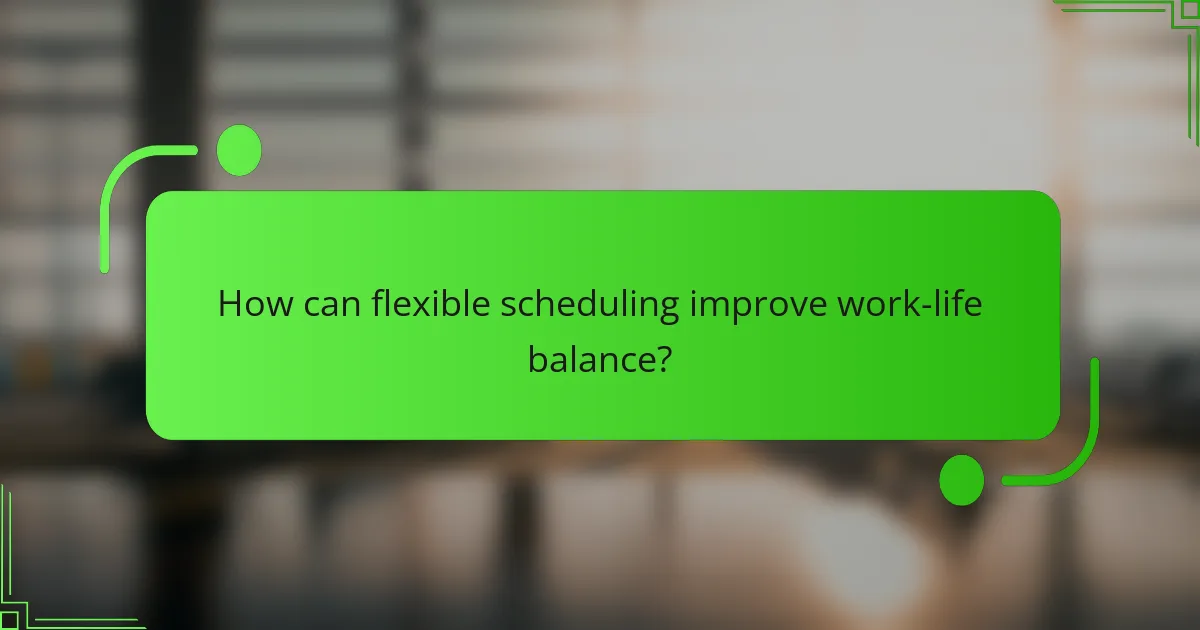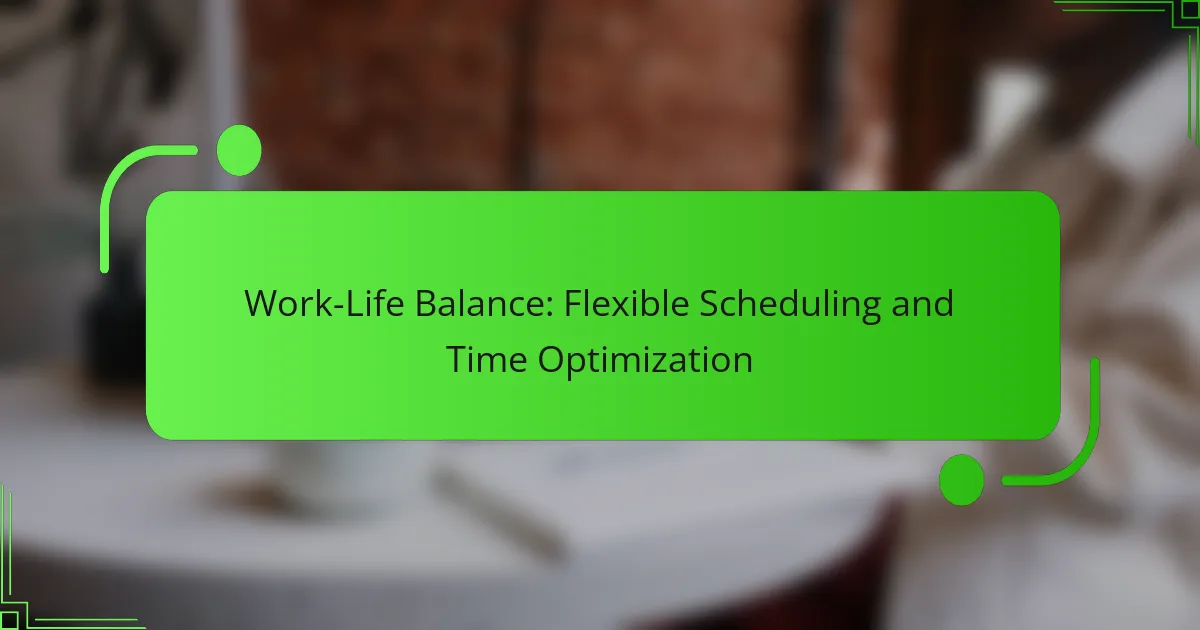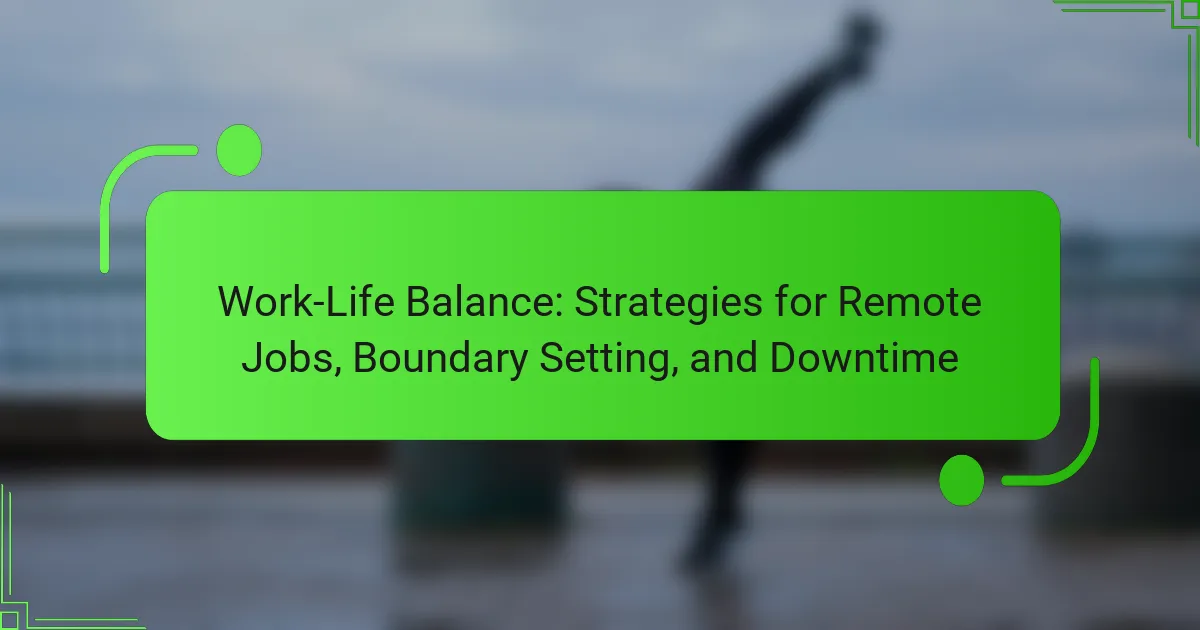Achieving a healthy work-life balance is increasingly important in today’s fast-paced world, and flexible scheduling plays a crucial role in this pursuit. By allowing individuals to customize their work hours, organizations can enhance employee well-being and productivity while meeting personal commitments. Implementing effective strategies for flexible scheduling and time optimization not only benefits employees but also aligns with organizational goals, fostering a more efficient and satisfying work environment.

How can flexible scheduling improve work-life balance?
Flexible scheduling enhances work-life balance by allowing individuals to tailor their work hours to better fit personal commitments and preferences. This adaptability can lead to improved efficiency and overall well-being.
Increased productivity
Flexible scheduling can significantly boost productivity by enabling employees to work during their most productive hours. For instance, some individuals may perform better in the early morning, while others thrive in the evening. By aligning work hours with personal peak performance times, tasks can be completed more efficiently.
Employers can support this by implementing core hours where all team members are available, while allowing flexibility outside of those times. This approach can lead to a more dynamic work environment and better project outcomes.
Reduced stress levels
Flexible scheduling can help reduce stress by allowing employees to manage their time more effectively. For example, being able to attend to personal matters, such as childcare or medical appointments, without sacrificing work commitments can alleviate pressure. This balance can lead to a healthier mental state.
Additionally, employees who can adjust their schedules to avoid peak commuting times often experience less stress associated with travel. This can contribute to a more positive work experience overall.
Enhanced job satisfaction
When employees have the ability to create a work schedule that suits their lifestyle, job satisfaction tends to increase. Flexibility can lead to a sense of autonomy and empowerment, making employees feel valued and trusted by their employers.
Organizations that promote flexible scheduling often see lower turnover rates, as satisfied employees are more likely to remain with a company that respects their personal time. This can ultimately foster a more committed and engaged workforce.

What are the best practices for implementing flexible scheduling?
Implementing flexible scheduling effectively requires a structured approach that balances employee needs with organizational goals. Best practices include establishing clear guidelines, utilizing scheduling tools, and maintaining open communication among team members.
Establish clear guidelines
Clear guidelines are essential for flexible scheduling to work smoothly. Define parameters such as core hours when all employees should be available, and outline how to request changes to schedules. This helps prevent confusion and ensures that everyone is on the same page.
Consider creating a written policy that details the process for flexible scheduling requests, including timelines and any necessary approvals. This can help manage expectations and reduce potential conflicts.
Utilize scheduling tools like Google Calendar
Scheduling tools like Google Calendar can streamline the process of managing flexible work hours. These platforms allow employees to share their availability, set reminders, and sync schedules with team members, making it easier to coordinate meetings and collaborative work.
Encourage employees to use color-coding for different types of work or personal commitments. This visual aid can help everyone understand each other’s schedules at a glance, enhancing collaboration and reducing scheduling conflicts.
Communicate with team members
Effective communication is crucial when implementing flexible scheduling. Regular check-ins can help team members stay informed about each other’s availability and any changes that may arise. Consider using team messaging apps to facilitate quick updates and discussions.
Encourage an open dialogue about scheduling preferences and any challenges employees may face. This fosters a supportive environment where team members feel comfortable discussing their needs, ultimately leading to better work-life balance and productivity.

What are the benefits of time optimization in the workplace?
Time optimization in the workplace enhances productivity and employee satisfaction by streamlining processes and reducing wasted time. By implementing flexible scheduling and prioritizing tasks, organizations can create a more efficient work environment that benefits both employees and the company.
Improved efficiency
Improved efficiency is a direct outcome of effective time optimization strategies. When employees are allowed to manage their schedules, they can work during their peak productivity hours, leading to faster task completion and reduced downtime. For example, allowing workers to choose their start times can result in significant time savings, as they can avoid peak commuting hours.
Employers can support this by utilizing tools like project management software to track progress and identify bottlenecks. Regularly reviewing workflows can also help in pinpointing areas where time can be saved, ultimately leading to a more streamlined operation.
Better focus on tasks
Time optimization fosters better focus on tasks by minimizing distractions and allowing employees to concentrate on their work. When workers have control over their schedules, they can allocate uninterrupted blocks of time for deep work, which is essential for complex tasks that require concentration.
Employers can enhance this focus by encouraging practices such as time blocking or the Pomodoro technique, where employees work in focused sprints followed by short breaks. This approach not only boosts productivity but also helps in maintaining mental well-being.
Increased employee engagement
Increased employee engagement is a significant benefit of time optimization, as it empowers workers to take ownership of their schedules. When employees feel trusted to manage their time, they are more likely to be motivated and committed to their roles. This sense of autonomy can lead to higher job satisfaction and lower turnover rates.
To further enhance engagement, organizations should regularly solicit feedback on scheduling preferences and be open to adjustments. Creating a culture that values work-life balance can lead to a more dedicated workforce, ultimately benefiting the organization as a whole.

How does remote work influence work-life balance?
Remote work significantly enhances work-life balance by providing employees with greater flexibility in managing their schedules. This autonomy allows individuals to better align their professional responsibilities with personal commitments, leading to improved overall well-being.
Flexible hours for personal commitments
Flexible scheduling enables employees to adjust their work hours to accommodate personal obligations, such as childcare, medical appointments, or education. For instance, a parent may choose to start work earlier to be available for school pick-up in the afternoon.
This adaptability can lead to increased job satisfaction and productivity, as employees can work during their most effective hours. However, it’s crucial to establish clear boundaries to prevent work from encroaching on personal time.
Reduced commuting time
Remote work eliminates the daily commute, which can save employees considerable time and reduce stress. Many individuals report saving anywhere from 30 minutes to several hours each week, allowing for more time spent on personal activities or rest.
With less time spent commuting, employees can use this time for exercise, hobbies, or family interactions, further enhancing their work-life balance. However, it’s essential to maintain a structured routine to avoid the risk of work-life boundaries becoming blurred.

What tools can help with time management?
Effective time management tools can significantly enhance productivity and help maintain a healthy work-life balance. Utilizing the right applications and techniques allows individuals to organize tasks, track their time, and focus better on their work.
Trello for task organization
Trello is a visual project management tool that helps users organize tasks using boards, lists, and cards. Each card can represent a task, allowing you to move it through different stages of completion. This method provides a clear overview of your workload and priorities.
To get started with Trello, create boards for different projects and use lists to categorize tasks by status, such as “To Do,” “In Progress,” and “Done.” This visual approach can help you quickly assess what needs attention and streamline your workflow.
RescueTime for tracking productivity
RescueTime is a time-tracking software that monitors how you spend your time on various activities, providing insights into your productivity patterns. By analyzing your daily habits, it helps identify distractions and areas for improvement.
To use RescueTime effectively, set goals for how much time you want to spend on productive tasks versus distractions. The software can send you weekly reports, allowing you to adjust your habits and optimize your schedule for better efficiency.
Pomodoro Technique for focused work
The Pomodoro Technique is a time management method that encourages focused work sessions followed by short breaks. Typically, you work for 25 minutes, then take a 5-minute break, with longer breaks after every four sessions. This approach helps maintain concentration and reduces burnout.
To implement the Pomodoro Technique, use a timer to keep track of your work and break intervals. This method can enhance your focus and productivity, making it easier to tackle larger tasks without feeling overwhelmed.

What criteria should be considered when choosing a flexible work model?
When selecting a flexible work model, it’s essential to consider employee preferences, company culture, and the nature of the work. These criteria help ensure that the chosen model enhances productivity while meeting the needs of both employees and the organization.
Employee preferences
Understanding employee preferences is crucial for implementing a successful flexible work model. Employees may have varying needs regarding work hours, remote work options, and the balance between personal and professional life. Surveys or informal discussions can help gauge these preferences effectively.
For example, some employees might prefer a four-day workweek for better work-life balance, while others may favor flexible hours that allow them to manage personal commitments. Tailoring the model to these preferences can lead to higher job satisfaction and retention.
Company culture
The existing company culture significantly influences the choice of a flexible work model. A culture that values trust and autonomy is more likely to support remote work and flexible hours. Conversely, a culture that emphasizes face-to-face collaboration may need to adapt gradually to such changes.
It’s important to communicate openly about the benefits and expectations of flexible work arrangements. This ensures that all employees feel included and understand how flexibility aligns with the company’s goals and values.
Nature of the work
The nature of the work performed by employees plays a vital role in determining the feasibility of flexible scheduling. Jobs that require high levels of collaboration or real-time communication may be less suited to flexible hours compared to roles that can be performed independently.
For instance, customer service roles may require specific hours to meet client needs, while creative or technical tasks might allow for more flexibility. Assessing the demands of each role helps in designing a flexible work model that maintains productivity and service quality.

How can companies measure the success of flexible scheduling?
Companies can measure the success of flexible scheduling through employee satisfaction surveys, productivity metrics, and retention rates. These indicators help assess how well flexible work arrangements meet both organizational goals and employee needs.
Employee Satisfaction Surveys
Conducting regular employee satisfaction surveys is a direct way to gauge the effectiveness of flexible scheduling. Questions should focus on work-life balance, job satisfaction, and perceived productivity. High satisfaction scores often correlate with successful flexible arrangements.
To enhance the surveys, include open-ended questions that allow employees to express their thoughts on the flexible scheduling policy. This qualitative feedback can provide deeper insights into areas for improvement.
Productivity Metrics
Monitoring productivity metrics is crucial for evaluating flexible scheduling. Companies should track key performance indicators (KPIs) such as project completion rates, quality of work, and time spent on tasks. A noticeable increase in these metrics can indicate that flexible scheduling is beneficial.
It’s important to compare productivity before and after implementing flexible schedules. This comparison helps identify trends and patterns that may arise from the new work arrangements.
Retention Rates
Retention rates serve as a significant measure of flexible scheduling success. High turnover can signal dissatisfaction with work arrangements, while improved retention suggests that employees appreciate the flexibility offered. Companies should analyze turnover data in relation to the introduction of flexible scheduling policies.
Additionally, exit interviews can provide insights into whether flexible scheduling influenced an employee’s decision to leave. Understanding these factors can guide future scheduling policies and improve employee retention strategies.



